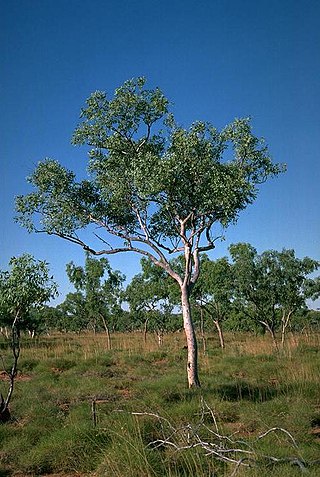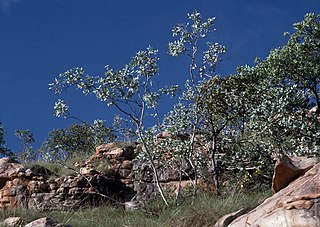
Eucalyptus moluccana, commonly known as the grey box, gum-topped box or terriyergro, is a medium-sized to tall tree with rough bark on part or all of the trunk, smooth bark above, lance-shaped adult leaves, flower buds usually in groups of seven, white flowers and cup-shaped to barrel-shaped fruit. It is found in near-coastal areas of Queensland and New South Wales.

Eucalyptus laeliae, commonly known as the Darling Range ghost gum or butter gum, is a species of small to medium-sized tree occurring only on the western side of the Darling Range. It has smooth white, powdery bark, lance-shaped adult leaves, flower buds in groups of between seven and eleven, creamy white flowers and cup-shaped to barrel-shaped fruit.

Eucalyptus rubida, commonly known as candlebark, ribbon gum or white gum, is a species of small to medium-sized tree that is endemic to south-eastern Australia. It has smooth bark, sometimes with rough bark at the base, lance-shaped or curved adult leaves, flower buds in groups of three, white flowers and cup-shaped, hemispherical or bell-shaped fruit.

Eucalyptus blakelyi, known as Blakely's red gum, is a tree endemic to eastern Australia. It has smooth bark on its trunk and branches, dull bluish green, lance-shaped adult leaves, flower buds usually in groups of seven, white flowers and cup-shaped to hemispherical fruit.

Eucalyptus mannifera, commonly known as the brittle gum or red spotted gum, is a species of small to medium-sized tree that is endemic to south-eastern Australia. It has smooth, powdery white bark, lance-shaped to curved adult leaves, flower buds in groups of seven, white flowers and cup-shaped, hemispherical or conical fruit.

Eucalyptus archeri, also known as alpine cider gum, is a mallee or a small tree that is endemic to Tasmania. It has smooth white or greyish bark, lance-shaped adult leaves, flower buds in groups of three, white flowers and conical to barrel-shaped fruit. It intergrades with E. gunnii.

Eucalyptus major, commonly known as grey gum, is a species of tree that is endemic to a small area near the New South Wales - Queensland border. It has smooth greyish bark, lance-shaped adult leaves, flower buds in groups of seven and conical to cup-shaped fruit.

Eucalyptus brevifolia, commonly known as snappy white gum or northern white gum, is a tree that is endemic to northern Australia. It has smooth, powdery white bark, lance-shaped adult leaves, buds arranged in group of seven, white flowers and cup-shaped or barrel-shaped fruit.

Eucalyptus herbertiana, commonly known as Kalumburu gum or yellow-barked mallee, is a species of small tree or mallee that is endemic to northern Australia. It has smooth bark, lance-shaped or curved adult leaves, flower buds in groups of seven, white flowers and cup-shaped, hemispherical or conical fruit.

Eucalyptus mooreana, commonly known as Moore's gum, mountain white gum or King Leopold Range mallee, is a species of stunted, straggly tree or mallee that is endemic to the Kimberley region of Western Australia. It has smooth, powdery white bark, a crown of juvenile, sessile, stem-clasping leaves arranged in opposite pairs, flower buds arranged in groups of seven, white flowers and cup-shaped to hemispherical fruit.
Eucalyptus tephroclada, also known as Holleton mallee, is a species of mallee that is endemic to the southwest of Western Australia. It has smooth bark, lance-shaped adult leaves, flower buds in pendent groups of nine to thirteen, pale lemon yellow flowers and barrel-shaped to cup-shaped fruit.

Eucalyptus thozetiana is a species of tree that is native to inland north-eastern Australia. It has smooth bark, or sometimes with rough bark near the base, linear to lance-shaped adult leaves, flower buds in groups of between seven and eleven, white flowers and urn-shaped, barrel-shaped or cylindrical fruit.

Corymbia bella, commonly known as the ghost gum, weeping ghost gum, or the paper-fruited bloodwood, is a species of tree that is endemic to northern Australia. It has smooth, powdery, white to pale grey bark, lance-shaped adult leaves, flower buds in groups of three, creamy white flowers and cup-shaped, barrel-shaped or urn-shaped fruit.

Corymbia bleeseri, commonly known as the glossy-leaved bloodwood or the smooth-stemmed bloodwood, is a species of tree that is endemic to northern Australia. It has thin, rough bark on part or all of the trunk, smooth bark above, lance-shaped to curved adult leaves, flower buds in groups of seven, creamy white flowers and barrel-shaped fruit.

Corymbia gilbertensis, commonly known as the Gilbert River ghost gum or Gilbert River box, is a species of tree that is endemic to tropical far north Queensland. It has rough, tessellated bark on the lower part of the trunk, smooth bark above, a crown of juvenile, intermediate and adult leaves, flower buds mostly in groups of seven, creamy white flowers and cup-shaped to barrel-shaped fruit.
Corymbia polysciada, commonly known as the apple gum, paper-fruited bloodwood or bolomin, is a species of tree that is endemic to the Top End of the Northern Territory. It has rough, tessellated bark on some or all or the trunk, smooth bark above, egg-shaped to broadly lance-shaped adult leaves, flower buds in groups of seven, creamy white flowers and cup-shaped, cylindrical or barrel-shaped from on long pedicels.

Eucalyptus confluens, commonly known as Kimberley gum, is a species of small tree that is endemic to northern Australia. It has smooth, powdery white bark, lance-shaped adult leaves, more or less spherical flower buds in groups of seven, white flowers and cup-shaped to hemispherical fruit. It grows in the Kimberley region of Western Australia and in adjacent areas of the Northern Territory.

Eucalyptus cupularis, commonly known as the Halls Creek white gum, or in the local indigenous Djaru peoples' language as wawulinggi, is a species of small tree that is endemic to an area in northwestern Australia. It has smooth, powdery white bark, lance-shaped or curved adult leaves, flower buds in groups of seven, white flowers and cup-shaped to conical fruit.

Eucalyptus decorticans, commonly known as the gum-top ironbark, is a species of tree that is endemic to Queensland. It has rough, dark grey or black "ironbark" on the trunk and larger branches, smooth white bark on the thinner branches, lance-shaped to curved adult leaves, flower buds in groups of seven, white flowers and conical, cup-shaped or barrel-shaped fruit.

Eucalyptus gregoryensis is a species of small tree or mallee that is endemic to the Northern Territory. It has smooth, powdery white bark, lance-shaped to curved adult leaves, flower buds usually in groups of three, white flowers and cup-shaped to hemispherical fruit.


















